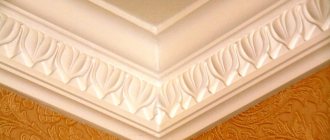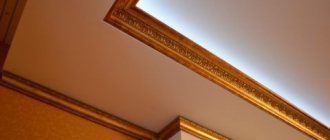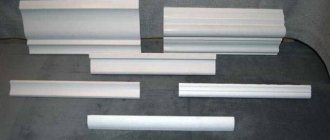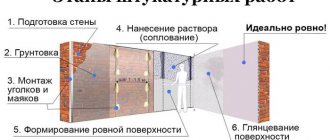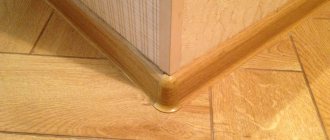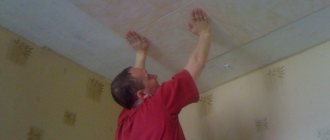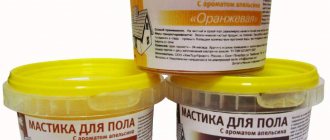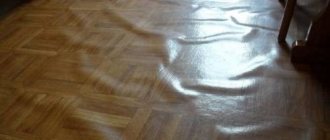How and with what to glue the ceiling plinth: the best compositions
Installing the ceiling plinth is the final stage of finishing the ceiling. This element can be mounted in several ways, but the simplest is by attaching it to ceiling plinth glue. What types and brands are presented on the shelves of a hardware store, how to make the right choice and competently finish the room?
How to choose glue
The ceiling plinth is designed not only to decorate the walls and complete the decoration, but also to hide possible repair errors and even the curvature of the walls. And for it to last a long time, you need to choose the right glue.
With all the diversity in the range of construction products, only some adhesives meet all the requirements necessary for a durable result when fixing skirting boards. When choosing an adhesive, it is important to consider the following properties:
- strength,
- ease of application,
- quick drying,
- no pungent odor,
- The product is designed for a specific material.
There is no special glue on sale specifically for ceiling plinths, but professionals recommend paying attention to the above characteristics. When choosing a glue, you need to start from what the finishing element itself is made of. Ceiling plinths are usually made of polystyrene foam, polyurethane, polystyrene foam, wood, PVC, and gypsum. Properly selected glue will not damage the material and will make the repair durable.
Titanium
"Titan" is an adhesive with an excellent reputation. The advantage of the product is its versatility: it is available in a wide range. The composition is capable of gluing not only ceiling plinths, but also linoleum, parquet boards, floor plinths and even ceramic tiles. Working with artificial leather and chipboard will be successful. Titanium is ideal for gluing foam skirting boards.
Titan contains polymer materials of a modern formula; there are no fillers. When using, there is no need to worry about expensive finishing materials, and all thanks to the transparent formula. In case of careless work, excess glue is easily removed from the front side of the fillet, walls and ceiling, and does not leave streaks. The only disadvantage of using such glue is that you need to hold the part for a while so that it grabs firmly, and your hands quickly become numb when raised.
Advantages and disadvantages
It is convenient to use adhesives to install plastic skirting boards. This is achieved due to the fact that the glue:
- Does not damage the floor, walls and baseboards;
- Fastening is carried out quickly and the product is held securely;
- Glue is a universal fastener (can stick to almost any surface);
- The connection is elastic and resilient.
The main drawback is that before you start attaching the planks, you need to level the base in advance. Otherwise, the material will look ugly and will not hold up well.
How to glue a plastic baseboard to a wall?
The plinth is one of the main decorative elements of the room. It gives the floor an aesthetic appearance, hides cracks and allows you to disguise wires. Today, wooden and plastic skirting boards are most in demand, but there are many other types. This article will discuss how to choose and how to properly attach the plinth to the floor.
Content:
Types of plastic skirting boards for floors
Plastic skirting boards are divided into two types - universal and for carpet. Universal applicable to all types of coating (laminate, wooden floors, tiles and linoleum).
To fasten the carpet, use an “L”-shaped plinth. It presses the carpet to the floor, preventing it from rolling, and at the same time, performs a decorative function.
Based on the composition of the material, plastic skirting boards come in four types:
- hard made of foamed PVC. This type is elastic, is not hollow, but breaks easily.
- hollow made of rigid PVC. They have high strength, but lower quality. To a greater extent, they are intended for simple decoration of premises without pretensions to sophistication.
- skirting boards made of semi-rigid PVC. Their composition is the same as foam. But they are distinguished by the high flexibility of the material and are sold in the form of tape in rolls. They have an aesthetic appearance, a wide range of colors, and can also imitate any natural materials.
Which type of skirting board is better - plastic or wooden?
Wooden plinths are environmentally friendly, but have a shorter service life. Plastic is made from synthetic PVC, but its service life reaches 100 years. Compared to their wooden counterparts, they have a number of advantages and are a serious competitor to other types of skirting boards.
Advantages of plastic skirting boards:
- Possibility of use in absolutely any room from the bedroom to the bathroom. And with a huge selection of colors, it won’t be difficult to choose the best option for each room;
- Compared to wooden ones, plastic skirting boards are more flexible and durable. They cut well and are easy to install;
- are not flammable, which makes them safer;
- have excellent moisture resistance, making them easy to wash;
- have an affordable price.
In addition to all of the above, most models of plastic skirting boards have a special groove for laying wires.
Based on the above differences, we can conclude that in most cases, plastic skirting boards are preferable to wooden ones. Naturally, there are exceptions when the design of the room involves the use of exclusively natural materials.
But even among plastic models, you need to choose the best option. As a rule, in appearance they are practically no different from wooden ones.
The classic option is a plinth with special fasteners and a hole for the cable. Its main advantage is that it hides wires and baseboard attachment points, and is also very easy to install. The second option is a plinth with a solid plastic structure, which is attached using clips.
The choice of one type or another depends on taste preferences and financial capabilities.
Components
Component elements include internal and external corners, connections and plugs. They have different shapes and colors depending on the type of baseboard.
- With the help of corners, skirting boards are connected in the corners of the room, which gives an aesthetic overall appearance.
- Interplinth joints are designed to extend the planks and to join them together. They are a piece of plastic with two slots for joining.
- Caps are needed to decorate the edges. For example, in places where the baseboard meets the doors. They come in two types, left and right, and are usually sold complete with a plinth.
Additional components include fasteners with which the planks are attached to the wall.
How to attach a plinth to the floor with your own hands
Today, there are three ways to attach a plinth, the main task of which is to secure it to the wall in a high-quality and durable manner.
Fastening with glue. It is not suitable for all rooms. In the case where the walls and corners are uneven, there is a very high probability that the baseboard will fall off the wall. But if the walls are smooth and all corners are 90 degrees, then this is the best option.
Installation using special latches that secure the baseboard. This method is suitable in absolutely any conditions. The main disadvantage of this type of fastening is that the latches do not withstand repeated installation, and after dismantling the baseboard you will need to buy new ones.
The last method involves direct fastening. The plinth is simply screwed to the wall with screws. The fasteners will be visible, but they can be disguised using special plugs matched by color. Also, the fastening points will not be noticeable if you use a plinth with a special groove for laying electrical wires. In this case, they are covered with a decorative cover designed to mask the wires. This method is the cheapest and most reliable of all of the above.
Tools required for work
To install skirting boards, you will need tools that are best prepared in advance:
- hacksaw for metal;
- awl (for making holes);
- roulette;
- pencil or pen;
- construction corner;
- drill with the necessary drill bits;
- screwdriver with the necessary attachment;
- hammer drill (if work is carried out in a brick house).
Ceiling baguette installation technology
The method of installing the ceiling plinth will depend on its type.
Overlay plinth
The decorative fillet, as mentioned, is glued to the wall on already installed panels. The fastening algorithm is as follows:
- Cut the edge of the plinth strictly at an angle of 45° relative to the front side.
- Apply glue evenly to internal surfaces.
- Glue to the wall, starting from the far corner of the room.
- Press carefully along the entire length.
- Carefully remove excess glue with a damp cloth.
- Give time to dry.
- Cover the remaining cracks with putty or silicone sealant.
PVC skirting board
The work begins with installing the frame on the entire wall. Wood slats or metal profiles are used for it. The bars are attached to the surface perpendicular to the direction of the plastic panels in increments of 40–50 cm.
On smooth walls, profiles can be fixed with dowels, but such surfaces are rare, so more often the product is fastened with screws, leveled using a level. In the collapsed areas, gaskets are made or wedges are hammered in to ensure strength to the frame.
The extreme slats adjacent to the corner joints will be the basis for attaching the ceiling plinth. By the time of gluing, one of the surfaces (wall or ceiling) must be finished.
The plinth for PVC panels is secured with self-tapping screws or construction staples. At the joints - in the internal and external corners - special inserts are placed on the glue, which greatly simplifies installation, making it more accurate.
Further installation of the panels will not be difficult: the guide groove of the plinth will not allow them to move to the side.
Fix the plinth just below the ceiling, then there will be room for the diode strip, which will act as additional lighting on the walls.
How much does it cost to install MDF skirting boards?
Wooden skirting boards - installation prices
| Services | Cost of work | |
| Height 5 cm | Height 6-7 cm | |
| Installation of wooden plinth (solid wood, veneer, MDF) | Price: 180 RUR/linear meter. | 230 rub/linear meter |
| Installation of europlinths with clips | Price: 450 rub/linear meter. Order | |
| Varnishing the baseboard | Price: 50 rub/linear meter Order | |
A comparative review of methods for attaching skirting boards: liquid nails, screws or clips?
Installing skirting boards is a traditional completion of floor installation or repair. Shaped strips made of plastic, MDF, wood hide technological gaps, unattractive elements, and communications if they are laid in special niches of the plinth. Skirting boards are attached in different ways to one of two surfaces: either to the floor or to the walls. The choice of the optimal option depends on the type of flooring, the material from which the plinth is made, and the preferred technology.
To complete the floor finishing, you can now purchase both traditional wood planks and more economical, easy-to-install plastic or MDF products.
Installation of skirting boards with cable duct
In this case, fastenings can be done using one of the described methods, but before starting work, remove the strip covering the cable channel from the baseboard, install it, install the cable and close the strip.
Depending on the material from which the plinth is made, one or more of the described methods for installing the specified elements is used.
Preparing for work
It is recommended to select tools and adhesive composition taking into account the type of material from which the decorative element is made. You can also use universal liquid nails.
Basically, acrylic and neoprene liquid nails are used to fix floor skirting boards. But in some cases other types of glue will be required. The latter include assembly (universal) liquid nails. This type of glue is used both for fixing polyurethane floor skirting boards and for sealing seams. This type of mounting nails has a dense consistency and high consumption. The universal adhesive composition does not provide a sealed seam, therefore it is not used in rooms where water leakage is possible. When choosing assembly liquid nails, you need to pay attention to what materials the product is suitable for.
DIY glue
If you have doubts about the quality of the products offered, try preparing the adhesive composition yourself. It's quite simple and not expensive. You will need:
- PVA glue;
- gypsum putty;
- water.
Stages of creating glue:
- Dilute the putty with water and stir until a thick and homogeneous mass is obtained.
- Add office glue to the resulting mixture in a ratio of 1:4.
- Stir the mixture and leave for 5 minutes. The glue is ready.
The disadvantage of this material is its long hardening time. Gluing the baseboard will take much more time compared to industrial adhesive products. But it is not forbidden to work with putty indoors, since it does not have a strong odor. Another plus is that during the gluing process, the composition can smooth out the unevenness of the wall. The mixture is applied with a spatula, after which the plinth is installed on it.
Baseboard mounting base - floor or wall
The floor and wall are perpendicular, which means that we have two options for fastening the skirting boards. The preferred method would be easier and more convenient. It is easiest to attach the strip to the surface that the screw will go into most easily. Thus, in houses with concrete floors and cement screed, it is recommended to fasten the plinth to the wall. In housing made of concrete and brick with a wooden floor, it is wiser to fasten the baseboard to the floor.
The process of attaching to the wall.
To attach the plinth to a floor with a concrete screed or to concrete walls, we first drill holes using a hammer drill, into which plastic dowels are then driven. The distance between the fastening points is determined by the degree of unevenness of the base, as well as the parameters of the baseboards themselves. The universal distance between the baseboard fixing points is the gap between 30 and 40 cm.
Walls that are finished or lined with plaster, or made of plasterboard, will become a poor platform for fastening skirting boards. Soft material will not allow the plinth to fix.
If there is no other way, then to fix it on a fragile material you need to buy special self-tapping screws that are suitable for working in such conditions, or finishing galvanized nails.
Peculiarities
Installation using adhesive is very quick. It is used if all surfaces of the room are almost perfectly level, otherwise the profile will look unsightly and will gradually begin to peel off.
Liquid nails (neoprene or acrylic), special mixtures made on the basis of polyurethane, acrylic putty (allows you to remove small irregularities), and a universal polymer adhesive composition are suitable for the job. Glues “Moment”, “88”, “Dragon”, “Titan” are often used.
Working with liquid nails made on the basis of neoprene components requires effective ventilation of the room. The unpleasant smell in the room after installing the panels will disappear after a few days.

